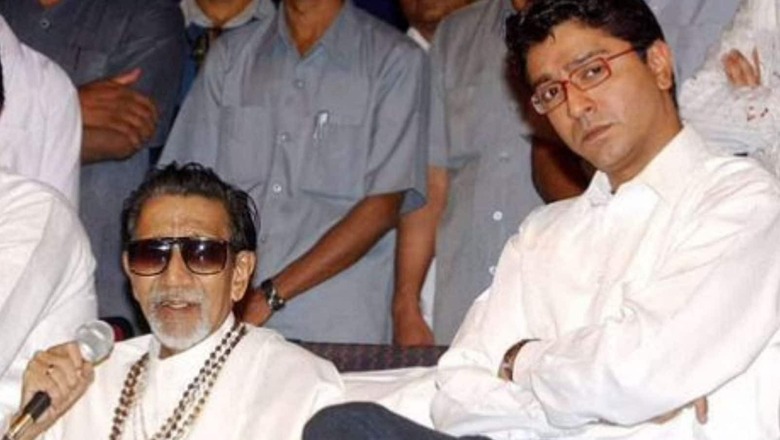
views
“I am Hindu, a mad, mad Hindu” — that is how Balasaheb Thackeray, the founding father of Shiv Sena, described himself.
Shiv Sena was started as a Mumbai-based local party in 1966 and remained so, catering to the base of Maharashtrians in the capital city and Thane region for the next two decades. Clearly, the party did not get the expected support in other areas of the state that it got in Mumbai and Thane with people not ready to buy its poll plank of ‘outsiders vs Marathi’. In those days, the state Congress leadership was considered very close to the Shiv Sena.
That’s where Hindutva came to help the party. With the adoption of Hindutva and Hindu nationalism as its core political ideology in 1980s, Shiv Sena saw an unprecedented growth across the state. The adoption of Hindutva means that the Congress, which claimed to be a secularist party, was now Shiv Sena’s main enemy with its future president Sonia Gandhi becoming Bal Thackeray’s bête-noire.
Shiv Sena and its grassroots-level cadre in villages, the district unit officials, its MLCs and MLAs, with many coming from the rural Maharashtra belt, imbibed that Bal Thackeray’s Hindutva push as described in a ‘Saamana’ article on December 5, 1992, “How does our Shiv Sainik appear as he is marching towards Ayodhya? Like the roaring lion spreading terror, with the gait of an intoxicated elephant, like the assault of a rhino which reduces to powder a rocky mountain, like the manoeuvres of a leopard: Our infinite blessings to these Hindu warriors who are marching towards Ayodhya”.
Two years after Bal Thackeray’s death, in January 2015, the Shiv Sena demanded that the words ‘secular’ and ‘socialist’ be removed from the Preamble of the Indian Constitution. For Shiv Sena, the country, a Hindu Rashtra, didn’t need these two words. The context was the information and broadcasting ministry’s Republic Day advertisement carrying the Preamble without the words ‘secular’ and ‘socialist’. The words were inserted into the Preamble with 42nd amendment in the Indian Constitution in 1976.
The advertisement created a controversy. The opposition parties said it was done deliberately by the government and was an “unforgivable sacrilege of the Indian Constitution”. The I&B Ministry clarified that there was no such intent and the advertisement was just to honour the ‘first Preamble’ with its original picture that was without these two words. The ministry also took a call that to avoid such controversies in the future, only the picture of the amended Preamble with words ‘secular’ and ‘socialist’ would be used in ads.
But Shiv Sena, then a BJP ally, had a different take on the issue. The party welcomed the exclusion of the words ‘secular’ and ‘socialist’. According to the Shiv Sena, as residents of the country felt so, these two elements should be deleted from the Indian Constitution permanently.
Sena, still a BJP ally during the 2019 Maharashtra assembly polls, decided to take the other route post the election result and chose to merge with the same parties Bal Thackeray saw as bitter enemies, as interpreted by a normal Shiv Sainik; parties claiming to be secular; parties that hated Shiv Sena’s push for Hindutva and Maharashtrians and its ‘outsiders vs Marathi’ drive.
Shiv Sena, which bagged at 56 seats, almost half of BJP’s tally of 105 seats, yet demanded the CM chair, broke alliance with the saffron party, and chose to tie up with the Congress and Nationalist Congress Party (NCP), which was formed by former Congress politicians; despite it enacting the 42nd amendment to include the words ‘socialist’ and ‘secular’ in the Preamble.
Was Shiv Sena cadre agreed with the decision to ally with secular forces? Did they agree to ally with a party that inserted the word ‘secular’ in the Indian Constitution that they were so fiercely against with?
Bal Thackeray had envisioned to have his party members follow his Hindutva push literally. So, if the Shiv Sena workers had decided to turn back on senior Thackeray’s words, then?
After following Hindutva for so long, targeting Congress, NCP and other parties and demanding the removal of words like ‘secular’ and ‘social’ from the Constitution, could Shiv Sena have fought a pan-India strong Hindutva force like the BJP in the upcoming election? Will it not be a political suicide for them?
Particularly, when the senior Thackeray would say that a ‘true national leader is the person who injects militancy into the Hindu bloods”, as quoted in an essay “The Rebirth of Shiv Sena” published in 1997 in ‘The Journals of Asian Studies” by Mary Fainsod Katzenstein, Uday Singh Mehta and Usha Thakkar on Shiv Sena’s emergence as a Hindutva-based political party.
A Not So Emphatic Beginning
Till mid-1980s, Shiv Sena was still a Mumbai-Thane centric party. Bal Thackeray said the Shiv Sainiks will fight for the pride of the Maharashtrians who were sidelined by the outsiders who used to usurp their jobs. So, the core aim of the Shiv Sena, when it was launched in 1966, was pushing for a ‘sons of the soil’ campaign — or fighting for the populist issues like ‘Marathi Ashmita’, jobs for ‘Marathi Manoos’, and Marathi language.
Congress, which ruled Maharashtra till 1995, was quite close to Shiv Sena in those days. Before Shiv Sena, the Left was the main opposition and its trade unions ruled the commercial capital of India. Congress saw in Shiv Sena a Marathi force that could counteract the impact of the Leftist unions in the city.
Shiv Sena saw a rapid rise in Mumbai-Thane region. The party got a good foothold in the municipal corporation elections and had four Bombay mayors in 1970s. Earlier, trade unions aligned with the Left ideology ruled the economical capital of India. Now, Mumbai’s streets became synonymous with Shiv Sainiks.
And here comes the Hindutva Ideology
By mid-1980s, though the Shiv Sena had become a force to reckon with in the Mumbai region, politically, it could not grow beyond the Maharashtra’s capital city. The next step was the state-wide growth but the party’s trusted card of sectarianism was not working.
By mid-1980s, Hindutva had started establishing itself as a major political ideology in India. Influenced by it, Shiv Sena started using Hinduism in its mix of political messaging and saw a miraculous swing in its support base as revealed in the senior Sena leader Sudhir Joshi’s words, “We don’t know how it happened. But the Sena is getting a tremendous response from people from all walks of life. They seem to have caught on with our concept of Hindu Rashtra.”
That swing set the next course of Sena’s political map – riding high on the political messaging of nationalism, patriotism, religion and anti-Muslim rhetoric. A political messaging that made ruling Congress, which once supported Shiv Sena, now its main enemy for following appeasement politics and allegedly following anti-Hindutva stand.
The core of Shiv Sena’s political ideology now was the line, “say with proud that we are Hindus” and Bal Thackeray’s reminder that “a true national leader is the one who will inject militancy into the Hindu blood,” as quoted above.
Demonizing anti-national Muslims who will burst crackers on Pakistan’s victory over India in a cricket match and championing the cause of Hindutva and Hindu nationalism in the times of Shah Bano and Babri Mosque-Ram Temple case was a perfect curry to the political mix Shiv Sena was looking for – Marathi Manoos imbibing Hindu nationalism. Savarkar, despised by the Congress was a national hero for a normal Shiv Sainik, and full integration of Jammu and Kashmir into India was a clarion call for them.
Shiv Sena a Major Political Force in Maharashtra
It was growth time. In the 1985 municipal polls in Bombay, the party won 70 seats, 49 more than the 21 seats it had won in 1978. Sena became the sponsor and promoter of Hindu festivals and Mumbai’s cultural hallmark — Ganesh Chaturthi — became a Sena festival. Maha Aartis in streets were another big part of the operation.
In 1989, the party got into an alliance with the BJP. Saw major electoral success in 1991 assembly elections with the alliance winning 94 seats and replaced the Congress government in the next assembly election in 1995. In 1985, both parties together had got just 16 seats in the assembly polls. It went to 138 seats in for the BJP-Sena alliance in 1995.
Can Current Shiv Sainiks Leave Senior Thackeray’s Ideology Behind?
Sonia Gandhi was one of the persons Bal Thackeray always targeted. He wrote in ‘Saamana’ in June 2010, “On the occasion of the census, I have a question regarding Sonia Gandhi and her family. Keep the caste aside, which religion will Sonia mention as hers in the census? The country must know it.”
Uddhav may praise Sonia Gandhi now but for the ordinary Sena leader, she was the one political leader to be avoided at any cost, “Mughals ruled us for over 600 years while the British ruled us for over 150 years. We do not like someone from amongst us on the top. We prefer imported leaders,” said Thackeray during his annual Dussehra rally in October 2007.
Just before his death on November 17, 2012, Thackeray had some scathing words for the first family of the Congress party, “Panch-kadi (gang of five) should be destroyed and thrown out of the country,” adding that “the country has become a nation of cheaters”. The gang of five targeted by Thackeray included Sonia Gandhi, Rahul Gandhi, Priyanka Vadra, Robert Vadra and Ahmed Patel.
True, it was Shiv Sena’s right to find other supporting parties with downward spiral in its ties with the BJP. There was nothing wrong in doing so but could the party compromise on its Hindutva plank that was behind its meteoric rise, behind making every Shiv Sainik a potent political force in Maharashtra? Could the party ally with the Congress that Balasaheb in fact detested, as evident by his words?
Clearly, the script of a rebel Sena MLA now becoming a Maharashtra CM and claiming that his faction with 50 MLAs is the real Shiv Sena, was already written in November 2019 when Uddhav Thackeray took oath as the CM for a Shiv Sena that chose to go with the Congress and NCP.
Read all the Latest News, Breaking News, watch Top Videos and Live TV here.



















Comments
0 comment